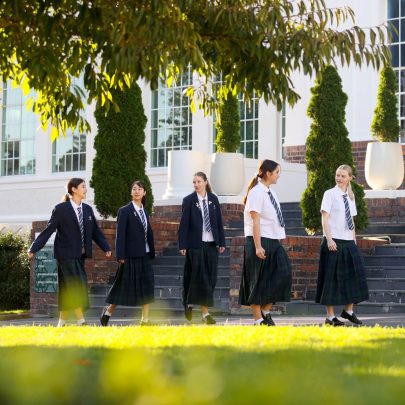Jun 27, 2014 Schools
Measuring the quality of a school is a complicated but worthwhile business.
Photo of students at Auckland Grammar by Simon Young.
Schools are not chicken farms. It would be so easy if they were. You could go along and measure plumpness, succulence and weight, and use that real, empirical evidence to decide which farms produce the best birds.
The difference between chicken farms and schools — all right, one of the differences — is that when the farm has finished with the chicken, that’s it, end of the line for the chicken, but when a school has finished with its students, they still have a lot more living to do.
We all know this, and what it means for schools. Their role is to help set young people up for a good life — however you might define “good”. But still, a lot of the time, we look at schools as if they really are chicken farms. We treat academic results as measures of weight and succulence in products that have no more growing to do. Ready to eat. We forget about all the other things that go into producing young adults who can embrace the possibilities of the world — at school and out of it — and we regard their academic achievement at age 18 as a full stop in their lives.
To be clear, academic results are critically important. Schools where students do not keep pace and, worse, schools that try to downplay the problem or make excuses for poor outcomes, are quite possibly schools to avoid.
But as Donna Chisholm’s feature this issue implies, the best measure of a school is its character. Are the students proud to be there? Are they comfortable around each other and do they share a pride in each other’s achievements? Do they focus on their activities — their schoolwork and the other things they do?
There’s a set of triple values in this: respect for others, a work ethic with high standards and, well, happiness. Without respect there will be bullying. Without promotion of effort and achievement there will be alienating failure. Without happiness — let’s call it the kids’ desire to be at school because they enjoy what it offers — there will be a reluctance to learn. Schools should hold these values high in meaningful ways that you can see and understand.
How to find out? Ask the students. Seriously. They’re extremely reliable witnesses.
You can do it through family and friends, and online through social media and websites like ratemyteachers. You can do it at open days — hot tip: if there are no students around to talk to on an open day, that’s a warning bell clanging right there.
How does a school relate to its families? In the sense that it takes a village to raise a child, good schools actively foster a community of home and school where each supports the other and they share each other’s roles.
Catholic schools are the shining example. Our table of results and the related analysis in the new issue is clear: pretty much every Catholic school in Auckland is doing remarkably well academically. One big reason is the ready-built home/school relationship they have through the church. It provides a set of shared values and an active commitment to each other. Secular schools can achieve those things too, and many do. But often it doesn’t come so easily to them.
Still, for an awful lot of students, the best school is the local school. If it has a good principal and enough good teachers, if it offers the range of curricular and extra-curricular opportunities you and your children value, if the spirit of the school seems to flourish and it seeks an active engagement with families and whanau, and if its academic results are tracking with or ahead of national averages for the decile, then the advantages of attending a school in your own community will be weighty.
And remember — being blunt here — for most people it’s a trap to think your child has special needs that a particular kind of school will look after best. A school is more likely to “suit your child’s personality” if it has an excellent principal than if it is “permissive” or “prescriptive” or has a good tennis club.
As our table shows, there are many examples of co-ed suburban state schools doing very well in Auckland: Macleans College leads the pack, but others worth noting include Lynfield, Mt Albert Grammar, Mt Roskill Grammar, Rangitoto, Takapuna Grammar, Western Springs and — growing in strength in the south, Southern Cross Campus and Tangaroa College. Among the single-sex state schools, Auckland Grammar, Auckland Girls Grammar, Epsom Girls Grammar, Kelston Girls, Kelston Boys and Westlake Boys High all have reason to feel especially proud. And those lists could easily be longer.
The reality of schools in Auckland, as in New Zealand, is that on the whole they do very well. As they are proud of what they do, we should be proud of them. The difficult question is what to do about the “long tail of failure”. Yet it shouldn’t be so difficult. The most remarkable thing about our table is what it reveals among low-decile schools: some do well, and some do not do at all well. Why the gap?
More to the point, isn’t it blindingly obvious that the ones doing well could teach something to the others? That’s one of the biggest tasks facing the next government. Minister Hekia Parata’s programme to identify expert teachers and principals and have them take mentoring roles in other schools is an excellent step in the right direction. But if she is to remain as minister, she will need to work out, pretty quickly, how to restore a working relationship with teachers. Everybody has to climb down from the barricades on this one.





